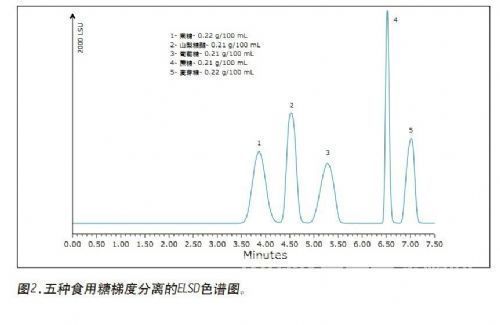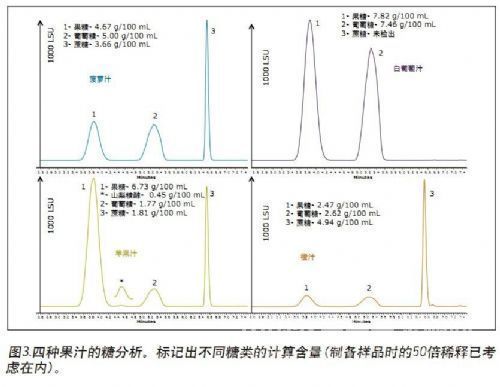purpose
In a short analysis time, with the simplest sample preparation possible, the sugar content in various juices was successfully determined in a cost-effective manner.
background
In recent years, studies have shown that sugary soft drinks are associated with obesity, coronary heart disease problems and the development of type 2 diabetes. Therefore, the healthy choice of using pure fruit juice instead of sugary soft drinks is highly respected. In addition, it has been reported that certain fruit juices, such as pomegranate juice, are beneficial to health due to their antioxidant content, resulting in high prices for such products.
To ensure product quality and meet the requirements of regulatory agencies, the juice industry must test products to meet specific standards. One of the indicators is the sugar content. Fructose, sucrose and glucose are important analytes in fruit juice analysis. Their content and relative ratio are different, and can be used as an indicator to identify different varieties.
HPLC combined with evaporative light scattering (ELS) detector has long been recognized as an effective technique for such analysis. Amino columns have long been used for sugar separation. However, this may form a Schiff base, resulting in shorter column life and inaccurate sugar quantification.
Using reliable XBridge? BEH Amide column, combined with the proven Alliance? HPLC system technology, rapid analysis and quantification of five kinds of edible sugar.
Waters (Waters?) Patented amide-based column can prevent the formation of Schiff base, eliminating the above problems. This study shows the versatility of Waters XBridge BEH Amide XP columns in sugar analysis.

solution
Various juices are purchased in the local market. Sample preparation only requires: these juice samples are subjected to high-speed centrifugation to remove pulp and other insoluble materials. Take a portion of the supernatant of each juice and dilute with a 1:50 water / acetonitrile mixture.
The analysis was performed using an Alliance HPLC system equipped with a 2424 evaporative light scattering detector. Since the target analyte has no chromophore, it is not suitable for UV and fluorescence detection, and the more suitable ELS detection is used. Gradient elution can be performed to separate related compounds such as other sugars, sugar alcohols (sorbitol), and high-carbon oligomers. The column used was XBridge BEH Amide XP 4.6 × 100 mm, 2.5 μm column. The binary mobile phase used for gradient elution consists of water and acetonitrile, with triethylamine (TEA) as modifier. Using the dilution of the sugar mixed stock solution, a six-point standard curve was established to quantify the sample. Figure 2 shows the separation of four kinds of edible sugar and sorbitol, sorbitol is a sugar alcohol, which can be used as a non-conforming product marker in some varieties. The analysis results of various juices are shown in Figure 3. It is worth noting that apple juice contains trace amounts of sorbitol.


to sum up
The XBridge BEH Amide column can be used to analyze sugar in juice in less than 7.5 minutes. Using the reliable XBridge BEH Amide XP column, referring to this method, the sugar in the juice can be accurately quantified. The proven Alliance HPLC system technology can accurately quantify the sugar in the juice to achieve accurate solvent delivery and Repeatable injection performance, and the ability to create non-linear gradients and perform simple ELS testing, which meets the goals of simplifying sample preparation, reducing analysis time, and increasing cost-effectiveness.
Bar Handle,Cabinet Handle,8Mm Cabinet Pull Iron Handle,12Mm Cabinet Pull Steel Handle
JOKER UNO LIMITED , https://www.jokeruno.com